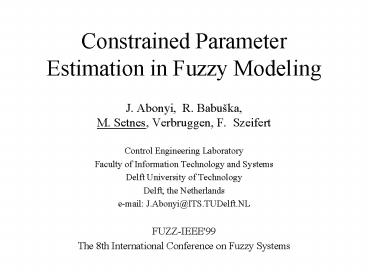Constrained Parameter Estimation in Fuzzy Modeling - PowerPoint PPT Presentation
1 / 17
Title:
Constrained Parameter Estimation in Fuzzy Modeling
Description:
e-mail: J.Abonyi_at_ITS.TUDelft.NL. FUZZ-IEEE'99. The 8th ... Stationary gain (global or local) Open-loop settling time (global or local) FUZZ-IEEE'99 ... – PowerPoint PPT presentation
Number of Views:24
Avg rating:3.0/5.0
Title: Constrained Parameter Estimation in Fuzzy Modeling
1
Constrained Parameter Estimation in Fuzzy Modeling
- J. Abonyi, R. Babuka, M. Setnes, Verbruggen,
F. Szeifert - Control Engineering Laboratory
- Faculty of Information Technology and Systems
- Delft University of Technology
- Delft, the Netherlands
- e-mail J.Abonyi_at_ITS.TUDelft.NL
- FUZZ-IEEE'99
- The 8th International Conference on Fuzzy Systems
2
Outline
- Problem formulation
- Proposed fuzzy modeling strategy
- Constrained parameter estimation of fuzzy models
- Formulation of a priori knowledge in inequality
constraints - Example identification of a liquid level process
- Conclusions
3
Problem formulation
4
The new fuzzy modeling strategy
5
TS fuzzy model as an LPV model
- Linear Parameter Varying (LPV) representation
6
The constrained parameter estimation method
- Prior knowledge ? local and global linear
equality and inequality constraints. - Rule-consequents define a convex region
(polytope). - This polytope can be constrained by global linear
constraints. - The individual rule-consequents can be
constrained separately local linear constraints.
7
Graphical representation of the method
8
Quadratic programming
- H and d contain the measured input-output data
- ? and ? represents the a priori knowledge based
constraints
9
Types of prior knowledge
- Sampling (global)
- Stability (global)
- Stationary gain (global or local)
- Open-loop settling time (global or local)
10
Example Stationary gain
- Upper and lower bounds
- Inequality constraints for QP
11
Example Liquid level process
- Process input Flow rate (0-100)
- Process outputLiquid level in the bottom tank
(0-100)
12
Identification data
- Process input
- Process output
13
Prior knowledge
- Open-loop stability
- Kmin 0, Kmax 2.5
- Settling-time of the local models
14
Identified models
- Model 1 No a priori knowledge was used
(VAF99.74) - Model 2 Prior knowledge on process stability and
steady-state gain (VAF99.74) - Model 3 Model 2 Settling time (VAF99.78)
15
All 3 models - good dynamic performance
16
but completely different local behavior
17
Conclusions
- Transform a priori knowledge into constraints on
model parameters. - Limited data prior knowledge ?good model
- Useful for control based on LPV model
- Detailed prior knowledge is needed
- Future research MIMO systems

